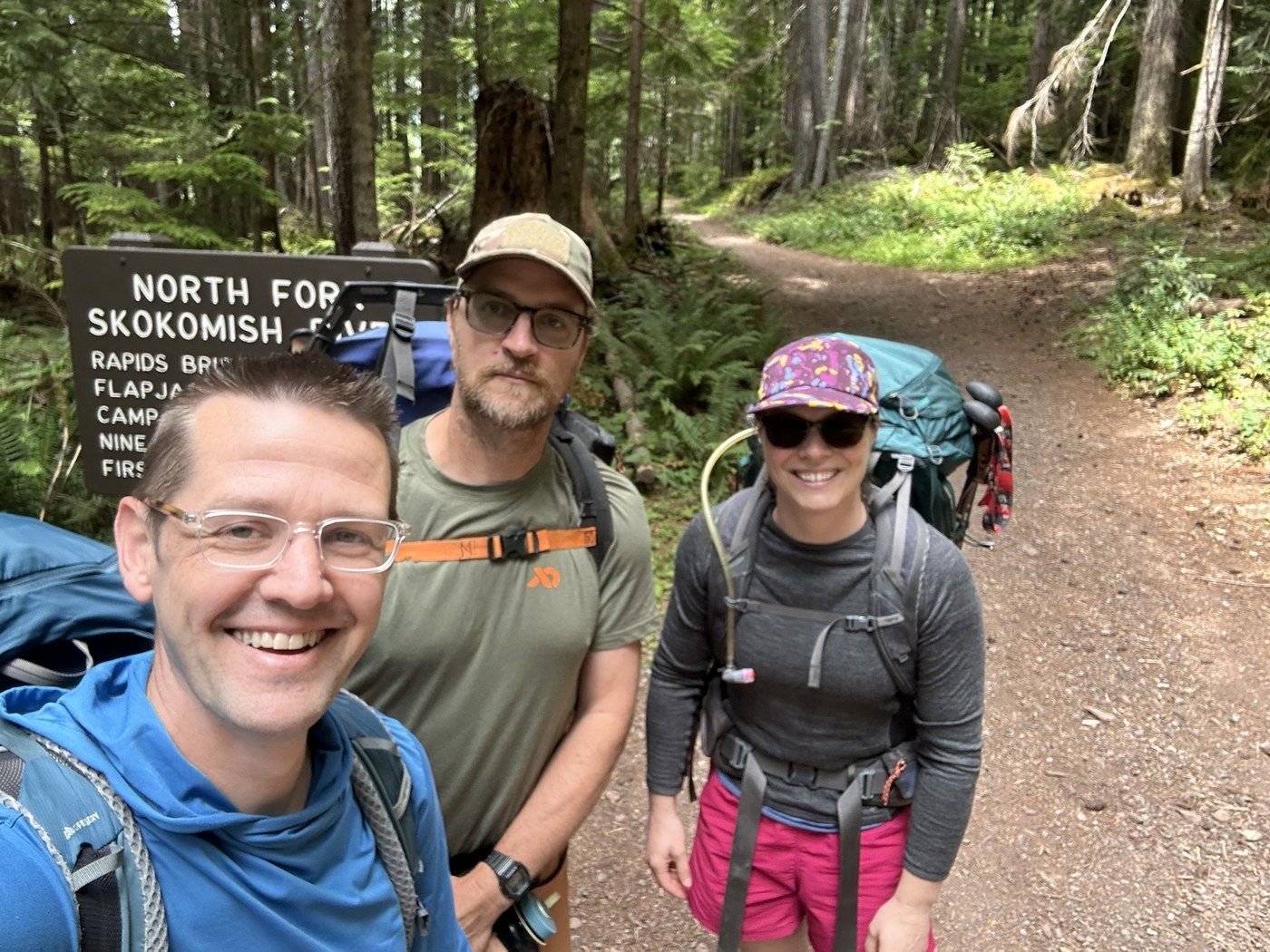Day 1: Thursday, July 3 — Staircase to 9 Stream Camp (10 miles)
We left Lacey around noon and arrived at the Staircase trailhead shortly after. Spirits were high as we hit the North Fork Skokomish Trail, hiking through stunning old-growth forest. The trail was in great condition and easy to follow, and good conversation made the five-hour, 10-mile trek fly by.
We approached the ford at 9 Stream with some caution, expecting a swift current due to early-season snowmelt. Thankfully, the crossing wasn’t too difficult—high enough to switch into sandals, but manageable. The camp itself was peaceful, with just a handful of other hikers (about 5–6 people) sharing the site. No bugs to speak of, which felt like a gift.
Day 2: Friday, July 4 — 9 Stream → First Divide → Upper Duckabush (~7 miles)
We started the morning with a steady climb—roughly 2,500 feet over 4 miles—to reach First Divide. The trail was bursting with wildflowers: columbine, lupine, and paintbrush added vibrant color to the hillsides.
Though we’d been warned by a ranger to expect solid snow above 4,000 feet and packed micro-spikes just in case, the snow turned out to be minimal. First Divide itself was snow-free and straightforward. There was some snow on north-facing sections of the trial, and were not hard or dangerous to cross.
After descending slightly, we reached Home Sweet Home for lunch. A curious deer repeatedly wandered near us while we ate, and the prairie was carpeted with small white flowers—the kind that bloom just after the snow recedes. We had a clear view of Duckabush Mountain and enjoyed the serenity before descending another 2,000 feet to Upper Duckabush Camp.
The camp was in great shape, with bear wires and a well-maintained privy. While about 15 people were camped here—including a large group—we didn’t feel crowded. That night, we enjoyed a rare treat: a small campfire, since fire bans weren’t yet in effect. Bugs stayed tolerable.
Day 3: Saturday, July 5 — Upper Duckabush → 10‑Mile Camp (~10 miles)
We started the day with a ford across the Upper Duckabush. The water reached mid-shin but wasn’t difficult to cross.
This stretch of trail was more rugged—muddier, brushier, and more lightly maintained. We’d heard reports of 50+ downed logs, but we only encountered about half a dozen that slowed us down. There was some debate over the mileage (maps conflicted between 7.1 and 10.4 miles), but it definitely felt closer to the longer estimate.
Arriving at 10‑Mile Camp, we found bear wires but no functioning privy—the toilet had been crushed by a fallen tree, and unfortunately, people had resorted to going wherever they could. The smell made it clear this was becoming a problem.
The site was also overrun by a large group from The Woods Project, which made things a little uncomfortable. After some negotiation, we gave up a prime campsite (complete with a table) in exchange for a bit more privacy. The site was completely full, and the bugs were noticeably worse than previous nights.
Day 4: Sunday, July 6 — 10‑Mile Camp → Duckabush Trailhead (~10 miles)
Our final day was a pleasant 10-mile hike out to the Duckabush trailhead. This section of trail was in much better condition—fewer blowdowns, less dense vegetation, and easier going overall.
The highlight of the day? Berries! Wild strawberries and raspberries were ripe and delicious, and we kept stopping to graze. Huckleberries and blackberries also lined the trail, adding an unexpected sweetness to our final miles.
At the trailhead, my wife picked us up and kindly shuttled us back to Staircase to retrieve our car. Just hours after we left, a fire broke out in the Lake Cushman area—making us extra grateful for our timing.
Summary & Takeaways:
Mileage: ~40 miles total
Conditions: Trail mostly in good shape; 10‑Mile Camp notably degraded
Snow: Minimal above 4,000 ft—crampons and ice axe not needed
Wildlife: Curious deer, tons of wildflowers, and summer berries
Highlights: First Divide views, wildflowers, Home Sweet Home lunch, campfire at Upper Duckabush
Lowlights: Sanitation issues at 10‑Mile Camp, overcrowding






Comments
Dreamer Deceiver on North Fork Skokomish River, Upper Duckabush, Duckabush River
Absolutely no reason to have a campfire, especially in the backcountry, these days. There wasn't a "fire ban" when the Bear Gulch fire started, and now look where we are.
Posted by:
Dreamer Deceiver on Aug 14, 2025 09:56 AM